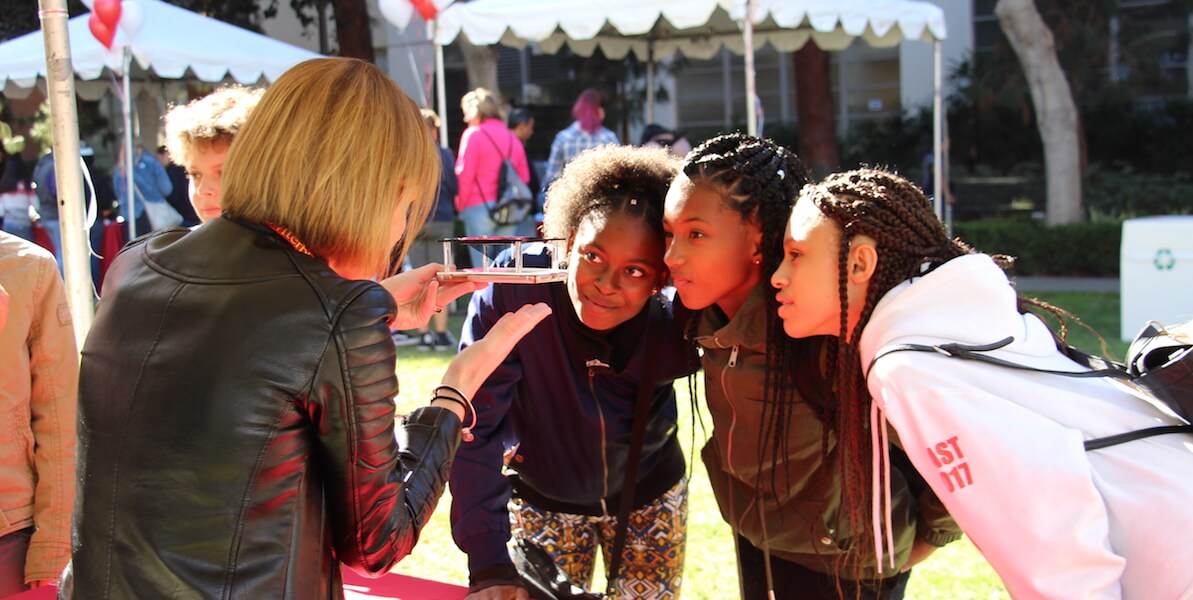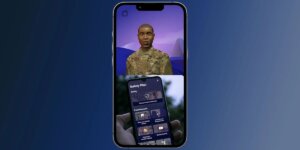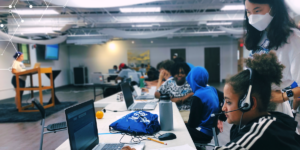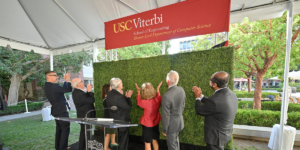
Students watch a demo at this year’s EngX/Photo credit: Jane Keranen
Lasers, robotics, cell-phone microscopes; all just a few of the topics of exploration offered to 5th-12th graders at the annual #EngX 2018 event, hosted by the University of Southern California Viterbi School of Engineering and Andrea Armani, the Ray R. Irani Chair in Engineering. The program, intended to open students to the possibility of pursuing a career in engineering through hands-on workshops, was held on February 24th at the Epstein Family Plaza at the University Park Campus.
According to Armani, a faculty member in the new USC Michelson Center for Convergent Bioscience, the drive to develop this event came from a desire to make engineering more accessible to younger students. “Quite simply, students can’t pursue a degree in something that they don’t know exists. My goal is to introduce students to engineering, and hopefully, to motivate some of the them to pursue engineering degrees.”
Though this the third annual event of its kind organized by Armani, who has expertise in chemical engineering, materials sciences and photonics, the event itself was some time in the making. “Planning EngX is like planning a party for 1000 people – with demos,” Armani said. “Fortunately [I have a lot of help] from the year-round cadre of student volunteers who design and troubleshoot our activities and make it happen. The majority of the effort is spread throughout the year, optimizing the different activities and figuring out ways to make this year’s event better that the one before.”
At one of the demonstration tables at the furthest end of Viterbi’s engineering quad, a number of students ages ten to seventeen hovered around a series of pipe mazes where small spherical robots traversed these paths.
Lily Tam, member of Theta Tau engineering fraternity and volunteer at the booth, gave an overview, “We’re working with Sphero robots,” she began. “They’re store bought — we’re programming them on our cell phones with this app called Spheroedu. Basically, this is simple coding. The coding we usually talk about at Viterbi is on a computer, you’re typing, but this is really just click and drag. We’re trying to make everyone use the robots to go through a maze, so they have to think about the speed the robot has to go at, what direction, etc. They have to take this all into consideration and kind of experiment with their hypotheses and then run the experiment.”
Tam went on to discuss her own expectations for the day, “We’re always trying to get more kids into STEM… so I hope they see that technology can be not just high tech but a lot of fun, as well.”
Volunteer and master’s student Amit Pandey also spoke to the benefits of science programming for young students. “Personally,” he began, “I feel that if this had been the case when I was growing up, I would have been at a much better level than I am right now. I remember playing with my first motor, and it [inspired] a lot of interest in me for electrical engineering.”
The students and parents also had a number of words to share regarding their perspective on the event. Vincent Medina, an 11th grader looking to pursue mechanical engineering, was especially impressed with the program. “It seemed like a really interesting opportunity to see what USC projects are,” he said. “So far, I’ve seen the sphero robots maze and programming — it seemed like something that would come in handy for mechanical engineering, like programming robots or something to do a certain task.
Megan Hansford, a volunteer from student organization Corpus Callosum, was surrounded by paints, pencils, and paper pinwheels. Hansford went on to explain that her booth was a demonstration on sustainability. The construction paper and pencils pinwheels were a vehicle to about wind energy and turbines. As for her hopes for the participants’ takeaway from the day, Hansford said “I hope that they can see that there is room for arts in engineering, and that there are creative and fun ways to learn about engineering that they perhaps hadn’t thought of before.”
But did the #EngX event provide anything different from what was being taught in school? Medina thought so: “It’s a little different — we’ve mainly been designing stuff, we haven’t really gotten into the programming field yet.”
Student Kaden Stolberg and her mother, Deborah, shared a similar perspective. “Kaden loves science,” Deborah began. “She always has. She’s in the science club at school, she just made the finals of the science fair, so we thought this would be a wonderful event. We’re really excited to be able to come and meet people who are doing what she loves.”
Kaden and her mother agreed that the sort of hands-on experiences they were witnessing at the event were a little further along than the kind of science they see in school. “I think it’s kind of similar — it’s the same stuff, but a little more advanced,” Kaden said. Deborah agreed: “It’s much more sophisticated than what they typically do in school — you can get the idea of how you can get here.”
The #EngX event, however, is ultimately one small piece in a greater puzzle. Armani pointed out that the necessity for events such as this one is two-fold: the need to provide children with role models and the need to show them that there are multiple paths to entry into engineering. “One of the reasons that some students are dissuaded from entering STEM degree programs in college is related to their math preparation in high school. Unfortunately, this path is determined in middle school when a decision is made about whether a student takes Algebra I or Pre-Algebra in 8th grade (or even Geometry in 8th grade). The idea that a decision in middle school will dictate a student’s career path is incorrect, and students need to realize this,” Armani noted. “Additionally, students need to see that math is so much more than solving equations – it is a gateway to biotech, bridge building, car design, and a whole host of other career options. The idea that engineering requires creativity is often lost.”
Ultimately, Professor Armani hopes that there is a significant takeaway regarding the importance of engineering to everyday life. “Engineering is the application of imagination to solve a real-world problem,” Armani said. “As engineers, we need to do a better job explaining the impact that engineering has on society. Engineers are responsible for life-saving inventions like the seatbelt, portable water filters, and quikclot bandages.”
Published on March 20th, 2018
Last updated on March 23rd, 2018













